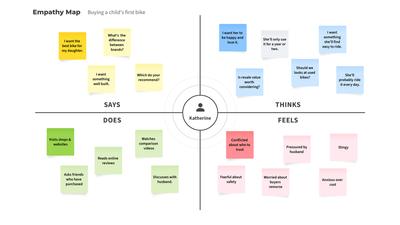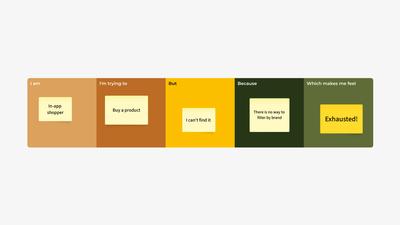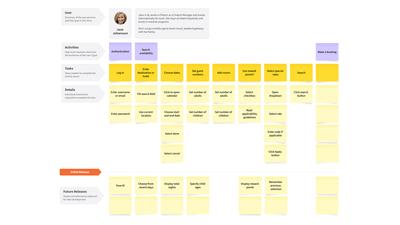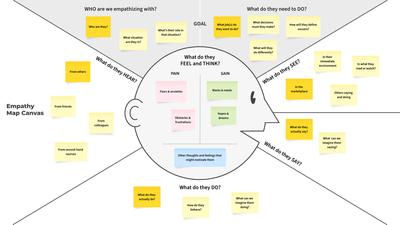- No results found.
Empathy Map Template
Use the empathy map template for a better understanding of your customers. Learn how they think and feel, or what they say and do while using your products.
Discover our empathy map template, a powerful tool that helps companies understand customers, by providing insights into their behaviors. Primarily used by UX teams, empathy maps are valuable starting points when working towards improving existing products or creating new ones that match user requirements.
What is empathy mapping?
Empathy maps are tools that provide useful insights into customer behavior, helping businesses understand their customers better. As it relies heavily on users' emotional intelligence, it reveals behavioral patterns and attitudes that enable companies to adapt their products according to users' needs.
Why are empathy maps important?
Customer empathy maps should be used in the early stages of the design process, as they enable teams to enter users' minds and provide snapshots of the world as seen from their perspective. It is a useful exercise before creating any solutions that design teams might assume customers need.
As customer experience is based on emotions almost entirely, empathy mapping helps businesses learn more about their users' emotions and, inevitably, become more self-aware as organizations.
How do you create empathy maps?
First, define the user's identity. Second, establish what it is you want the user to do - what does user success look like in this case?
Those who take part in the empathy mapping session need to bring in user data, personas, or any other insights they have on the targeted audience. Our empathy map template features four quadrants that reflect four key elements closely observed during user research. These can be looked at as the main empathy map questions that teams need to address:
- What does the user say about a product?
- What does the user do while using the product?
- What does the user think about the product?
- How does the user feel about the product?
All participants should use sticky notes to answer each of these questions. All sticky notes should then be placed into the corresponding quadrant of the empathy map. Every answer needs to be analyzed carefully to ensure deeper insights are extracted. Whether it's through questions or drawings, this session must focus on bringing the user to life.
Benefits of using the empathy map template in Moqups
Our empathy map template comes with a set of features such as sticky notes, drawing tools, comments, and annotations that you can use throughout the entire process.
As an online collaboration tool, everything is stored in one place, and all team members can participate in real-time to the empathy mapping session, eliminating the need to be in the same place at once. Everyone stays focused on the customer by connecting personas to business rules in one project.
Furthermore, Moqups offers the possibility to mix and match the empathy map with other related templates that help companies build personas and facilitate the process of understanding their customers.




